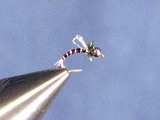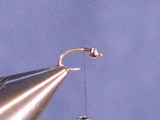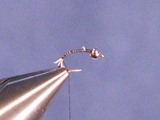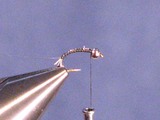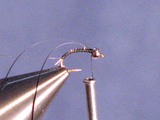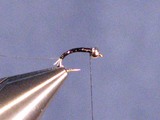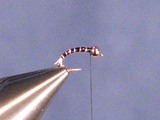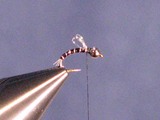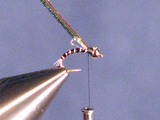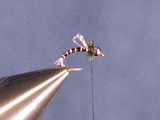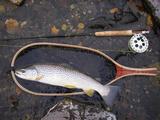Disco Zebra Midgeling
The Disco Zebra Midgeling is a pattern derived from combining the Disco Midge pattern with Mike Mercer's successful Zebra Midgeling pattern. Mercer's pattern is based off of the ubiquitous Zebra Midge, which is about as simple as a pattern can get: a thread base, wire ribbing, and a metal bead head. Mercer modified the Zebra Midge by adding triggering characteristics to the fly to help entice reluctant trout to feed. In my fishing and tying of Mercer's pattern, I've found that I like to make two modifications to the pattern, especially for smaller sizes, that results in the Disco Zebra Midgeling.
The Disco Zebra Midgeling has proven to be an effective pattern drifted off a dry fly like a small caddis or Griffith's Gnat, as well as drifted deep as a dropper off a bigger nymph. For me, a red version of the fly has worked well on clear freestone streams as a dropper off a small dry. In multiple instances I've seen fish move more than one foot off their feeding lane to take the nymph. On a tailwater river with excellent midge populations, I've used both small black and light-blue Disco Zebra Midgelings drifted off the bottom and taken very good numbers of trout. The fly has out-produced standard nymph patterns many times for me, and is now a go-to fly in my box.
One of the changes Mercer made to the original Zebra Midge is he wrapped the fly body in clear tubing. I feel this makes the fly body too thick for most small midge patterns (#18 and smaller). Mercer also likes the use of ostrich herl for the fly collar behind the head; again, while this works for larger flies, the herl feels too large to me to be used on smaller patterns.
The Disco Midge is a similarly simple pattern to the Zebra Midge, but instead of the thread body it uses flashabou to make a thin, colored, reflective body. I like the use of flashabou on the Disco Midge and substituted flashabou for the body of the Zebra Midgeling. The other change I like to do on Mercer's pattern is to use peacock herl instead of ostrich herl for the fly's collar. While it doesn't have the same movement as the ostrich herl, the peacock herl fits the fly's profile better while also adding some irresistable iridescence.
The following are the fly tying instructions for the Disco Zebra Midgeling.
Materials
| Hook: | Tiemco 2487, #16-#22 |
| Thread: | Uni 8/0 |
| Tail: | Angel Hair - Polar Ice |
| Body: | Flashabou (black, red, olive, lt blue are most common) |
| Ribbing: | Ultra Wire X-Small silver wire |
| Wing: | Pearl Krystal Flash |
| Collar: | Peacock Herl |
| Head: | Bead (black bead for black, olive, lt blue bodies; copper bead for red flies) |
Tying Instructions
Comments
Troy Pearse
Sweet pattern! It worked for me. :)


